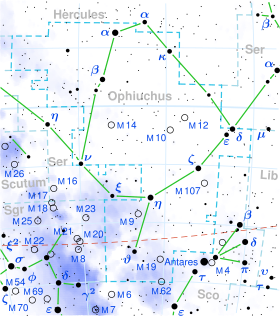41 Ophiuchi is a binary star[8] system in the zodiac constellation of Ophiuchus, and is positioned less than half a degree to the south of the celestial equator. It is visible to the naked eye as a faint, orange-hued point of light with a combined apparent visual magnitude of 4.72.[2] The distance to this system is approximately 202 light years based on parallax.[12]
This is a visual binary with an orbital period of 141 years and an eccentricity of 0.866.[8] The magnitude 4.92[3] primary, designated component A, is an aging K-type giant star with a stellar classification of K2III.[5] It is a red clump giant,[4] which indicates it is on the horizontal branch and is generating energy through helium fusion at its core. The star is 3.7[9] billion years old with 1.46[9] times the mass of the Sun and has expanded to nearly 12[1] times the Sun's radius. It is radiating 60[1] times the Sun's luminosity from its swollen photosphere at an effective temperature of 4,509 K.[9]
The secondary companion, component B, has a visual magnitude of 7.51 and an angular separation of 0.70″ from the primary along a position angle of 22°, as of 2017.[3]
- ^ a b c d e f g h i Cite error: The named reference
GaiaDR2was invoked but never defined (see the help page). - ^ a b c d Cite error: The named reference
XHIPwas invoked but never defined (see the help page). - ^ a b c Cite error: The named reference
WDSwas invoked but never defined (see the help page). - ^ a b Cite error: The named reference
Alves2000was invoked but never defined (see the help page). - ^ a b Cite error: The named reference
Hoffleit1991was invoked but never defined (see the help page). - ^ a b Cite error: The named reference
Mallama2014was invoked but never defined (see the help page). - ^ a b Cite error: The named reference
Massarotti2008was invoked but never defined (see the help page). - ^ a b c Cite error: The named reference
Tokovinin2015was invoked but never defined (see the help page). - ^ a b c d e f Cite error: The named reference
Luck2015was invoked but never defined (see the help page). - ^ Cite error: The named reference
AllendePrietowas invoked but never defined (see the help page). - ^ Cite error: The named reference
SIMBADwas invoked but never defined (see the help page). - ^ Cite error: The named reference
vanLeeuwen2007was invoked but never defined (see the help page).

